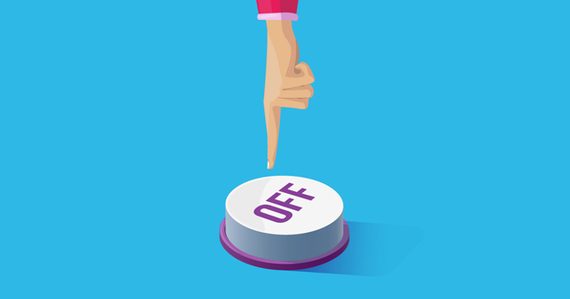Image: mbaldenkova via Adobe Stock
Why you can't find your off-switch
People often tell me:
'I don't have an off-switch!'
'I don't know when to stop eating!'
'Once I start, I can't stop eating - it's like I have no off-switch!' or
'I've never had an off-switch'
It breaks my heart to hear this. Having the experience of not being able to stop eating is incredibly disheartening. It's almost like not having control of your bowels - truly! Eating is a basic human function, and not being able to stop when you know you're no longer hungry can bring up all sorts of harsh criticisms:
- I'm useless
- I'm hopeless
- I'm pathetic
- I'm a loser
- I'm weak
None of which are true of course - but your mind will keep throwing that stuff up.
There are two reasons that your eating off-switch is hard to find:
You're not eating when you're comfortably hungry
Your off-switch works best when you begin to eat at a place of 'comfortable hunger' - this is before ravenous hunger! It's easier for your body to recognise its level of satiation when you begin to eat when you're at this place of 'comfortable hunger'. When you get too hungry, the body goes into a state of deprivation - particularly if you're a serial dieter. Your body will be on high alert in this case, because it will get into a fear state about how long this famine will last - and will want to eat a lot more than needed to prepare for starvation. It's called The Last Supper Syndrome.
But equally - starting to eat when you're not actually hungry also makes it more difficult for your body to flip the off-switch. Your off-switch needs to reference itself in relation to the 'on-switch' - and your 'on-switch' is at comfortable hunger.
You're not giving yourself unconditional permission to eat
Conditional permission looks like this:
- I'll allow myself one
- I'll just have 2 more and then I'm done
- I'll have this today but tomorrow I'm back on [insert diet or calorie/macro counting regime]
- I'll finish these off now so they won't be around to tempt me
- I'll try this unconditional permission thing for a week and if I put on weight, it's not working - and that'll be it with that little experiment!
- I'll try this unconditional permission to eat business provided that I stop bingeing
- I'll try this unconditional permission to eat idea as long as it means I'll lose the desire for [insert name of 'trigger food']
Unconditional permission to eat means without any conditions. No amounts of food you'll allow. No self-imposed conditions around weight gained or lost through doing this. No time frames. No hidden agendas about restricting them in the future.
Any kind of limit (tacit or explicit) can set off the deprivation cycle which inevitably leads to binge eating.
It's similar to the concept of Eve and the forbidden fruit. The prohibition of the apple made it all the more desirable. The similarity in the story ends there though - because giving yourself unconditional permission to eat won't lead to punishment, as it did with Adam and Eve!
It'll lead to freedom instead.
So these two pieces together: Eating when you're comfortably hungry, and giving yourself unconditional permission to eat whatever you want is where you'll find your off-switch.
I run a free Facebook group It's Not About The Weight, which you're very welcome to join.
